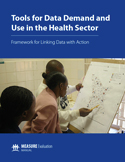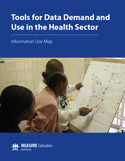PREPARE, ANALYZE AND REPORT DATA
Through development of a data use strategy, program teams can specify how data will be analyzed, which routine reports will be produced, and which indicators will be included in reports. A data use strategy should include how you intend to use data from all health information data sources related to malaria case management. Review the following resources when developing your data use strategy.
Quantitative data analysis includes processes like data tabulation, calculating descriptives like the mean, minimum and maximum values, median, and mode, data disaggregation and statistical analysis. While this guidance will not provide guidance on all of these processes, make sure your program makes the following clear:
- What are your research questions?
- Who is your primary audience?
- What kind of data is needed and what is the timeline for collection and analysis?
- What sample size will you need?
Adapted from Evaluation Toolkit
Analyzing qualitative data is often done manually, or by using software like NVivo or Atlas.ti. Other options include manual cut, sort, and paste methods. Regardless of which qualitative data analysis is done, the following steps should be taken:
- Organize data into themes: The expression of similar ideas should be grouped. Once you have a number of grouped ideas, organize them into broader themes.
- Develop a narrative: Present your findings in the words of those who provided you with their ideas. Organize a narrative into the themes that emerged and tell the story of people's experiences.
Adapted from A Step by Step Guide to Focus Group Research
The MEASURE Evaluation project offers detailed guidance on data use, data use strategies, frameworks, and training resources.
 Framework for Linking Data with Action
Framework for Linking Data with Action
This resource describes how data collectors, researchers and M&E specialists can visualize how their work can be applied to programs. The document includes templates for identifying beneficial applications for existing data, requirements to base upcoming decisions on, and a timeline for planning data dissemination.
The Information Use Map identifies existing data reporting channels and opportunities to increase the use of information to benefit programs and people. The document includes a Planning Matrix template to assist users in outlining a sequence of steps to improve information flow.
A data use strategy should answer the following questions:
- How will data be analyzed (e.g. type of software)?
- How often does data need to be reviewed for ideal performance management? By whom?
- How can the data be used to improve the program, as ongoing process improvement, and learning for future programs?
- Who else might want to know about or use these data?
- What is the best way to disseminate the results to interested stakeholders?
Reporting Qualitative Data: Focus Groups Example
Qualitative data is not representative and, as such, reporting should avoid use of numbers. "Some participants"or "the majority of those surveyed" are ways to convey quantity without enumeration. This is an important way of establishing what is known without wrongly framing this research as a representative sample of a given population. For this same reason, those mentioned should be referred to as "participants" and not "citizens", as the latter would imply the nation as a whole. Written reports for focus groups often take one of the following forms:
- Narrative reports: The provision of detailed description with contextual details regarding participants and their environment. This report will be based on questions asked and tell a story that illustrates lessons learned.
- Analytical reports: A description of events, organizations, situations, issues and processes. These reports will be organized by themes as issues.
For further information about how to ensure focus group written reports are as accurate and visually appealing as possible visit this resource at NGO Connect.
Congratulations! You have completed the SBCC malaria case management M&E implementation kit. Combine the situation analysis that describes your priority behaviors, your theory-based M&E framework, M&E plan, M&E budget, and details about data collection, use, analysis and reporting into a single document.
If you want examples of how actual programs have designed and carried out M&E plans using processes outlined here, continue to the examples section.


